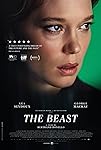Eye For Film >> Movies >> The Beast (2023) Film Review
The Beast
Reviewed by: Anne-Katrin Titze

Bertrand Bonello’s The Beast (La Bête, inspired by Henry James’s The Beast In The Jungle), starring Léa Seydoux and George MacKay (original score by Bertrand and Anna Bonello), is a highlight in the Main Slate of the 61st New York Film Festival. In the 1903 novella The Beast, the female protagonist proclaims: “That’s it. It’s all that concerns me - to help you to pass for a man like another.” The male protagonist is happy to hear this and after a grave pause she continues, “By going on as you are.”
The Civil War mentioned as an aside in Bonello’s film, which takes place in three distinct points in time (1910, 2014, and 2044), is that of 2025. As musical variations on a theme, The Beast explores what Henry James diagnosed so devastatingly. The chill of egotism and the feverish dance around the void are so desperately relevant today that it leaves one breathless. Gabrielle (Léa Seydoux) and Louis (George MacKay) meet in the earlier sequences with some of the James dialogue reversed in gender and a subplot of doll-making added, which makes you think of ETA Hoffmann’s 1817 story The Sandman.

We are not eased into the plot of fear of love by Bonello, quite the opposite. In front of a green background, the invisible director tells Seydoux to imagine a beast. The actress is dressed in black jeans and barefoot. There is a green table and a knife. A closeup of her face. A scream. The film’s title. And there she is, with an intricate curly updo and an elegant Fortuny gown. Paul Poiret would like to dress her, we hear. We are at a buzzing society party of 1910 and Gabrielle is looking for her husband Georges (Martin Scali). Instead she runs into Louis, an acquaintance she met in Rome three years prior, or Naples six years ago - depending on whom you ask. Louis notices under the glove the shape of a wedding ring.
2044, Gabrielle wants a new, more interesting job. But that is only possible if her affects don’t affect her, as she is told by a bodiless entity. Or does she want to revive 2025? Bonello is smart to say no more, as each viewer will fill in the blanks with personal scenarios of doom. To “clean her DNA” she has to undergo a special process, resulting in a state where she won’t feel anything anymore. The Paris of the near future looks empty, now and then a deer strolls by, or a dog. It is clean and looks abandoned and the remaining passers-by wear face visors. Cleansing old traumas is what everybody does. It’s so convenient.
Paris in 1910, meanwhile, is concerned with the floods. Will the waters rise? Will Paris look like Venice? Each epoch, each year has its specific fear. Gabrielle’s husband manufactures dolls. “How do you create a doll face?” Louis asks. Gabrielle shows him. It is a face without expression, it is the future. And the past, Mary De Morgan’s 1877 tale A Toy Princess may come to mind. Or Greta Gerwig’s Barbie and Yorgos Lanthimos' Poor Things of 2023.
Doll Kelly (Guslagie Malanda) from 2044 is life-size and at Gabrielle’s service. Madama Butterfly gives pause, clairvoyants spin their yarns and sometimes death by fire or by water seems the only choice. In 2014, the song You Belong To Me has turned into a stalker’s mantra. Louis has become a loner who wants to take revenge on women and sends his violent thoughts out into the world via social media. “I almost want it to last,” he says about the earthquake shaking up Los Angeles. Sunset Boulevard becomes prediction and curse and another death by water.
Lots of clairvoyant details, a pigeon in the house, music as the spirit of its years, the power of dance, tears and knives and floods and a brilliant brooch of wings speak of a panorama of the same beast to look out for. The unfilmable text has found its 21st century elucidation.
Reviewed on: 05 Oct 2023















